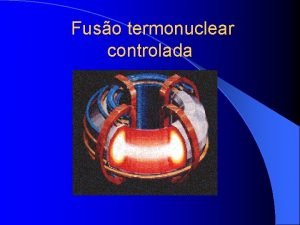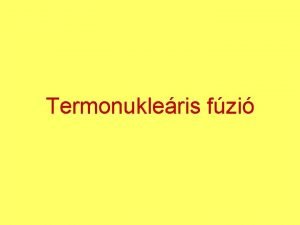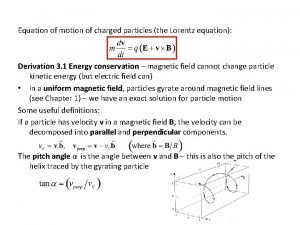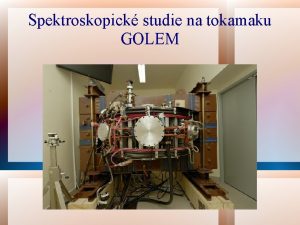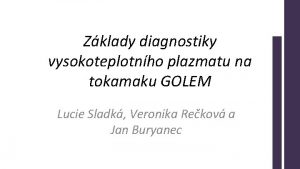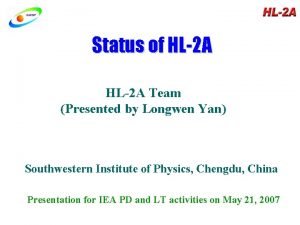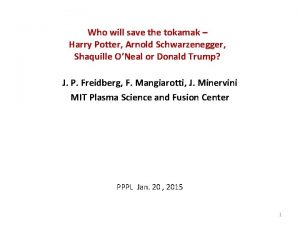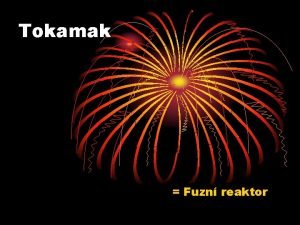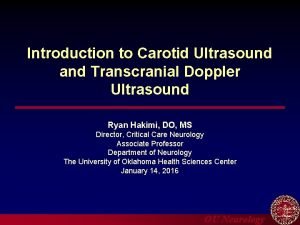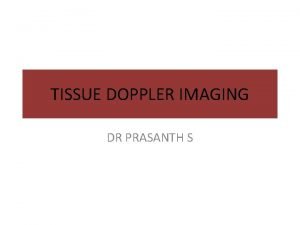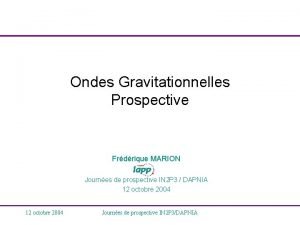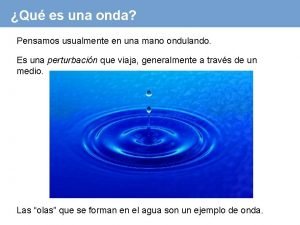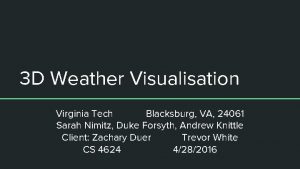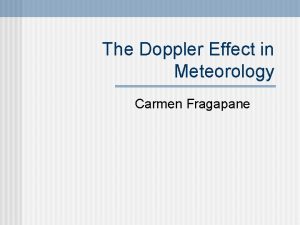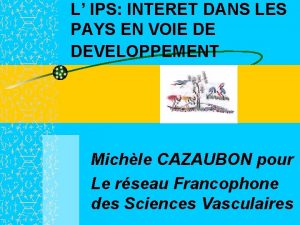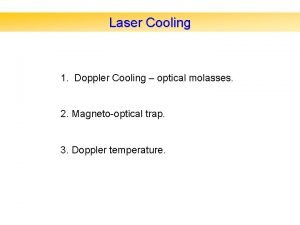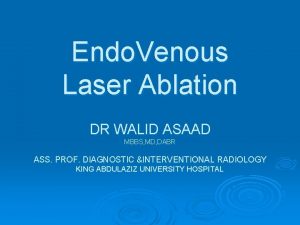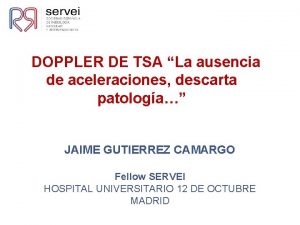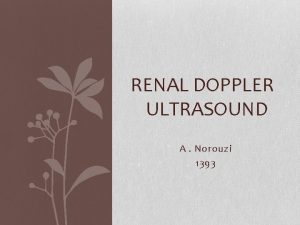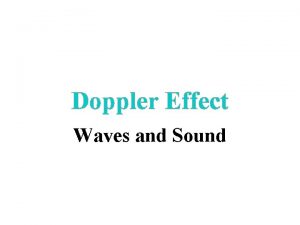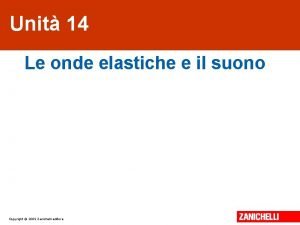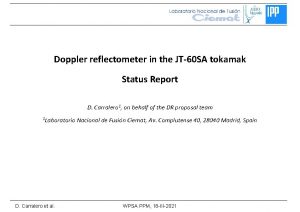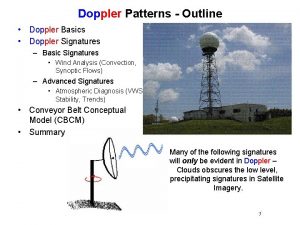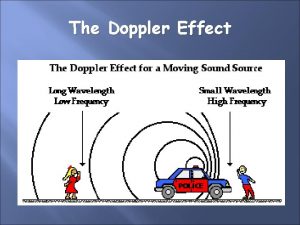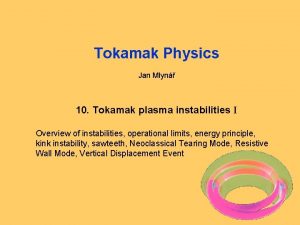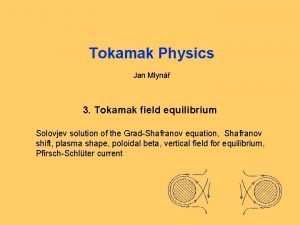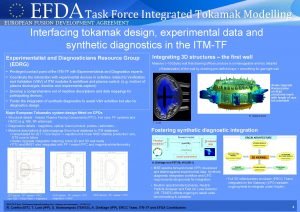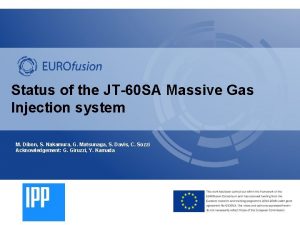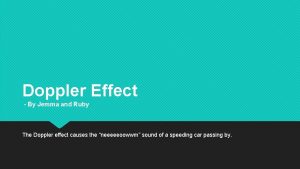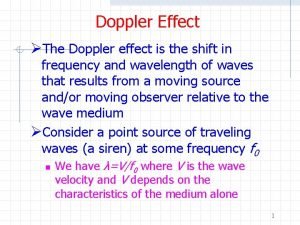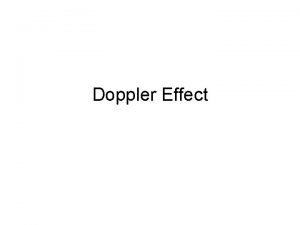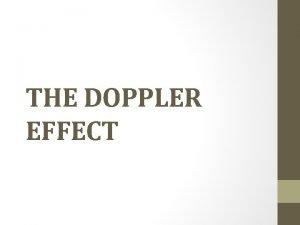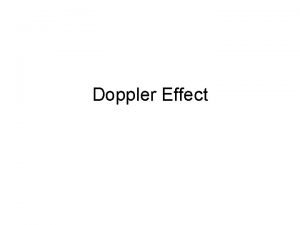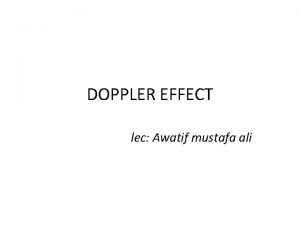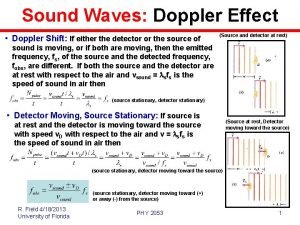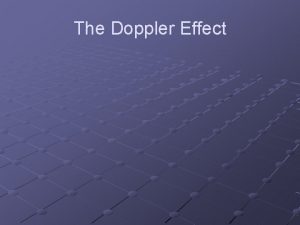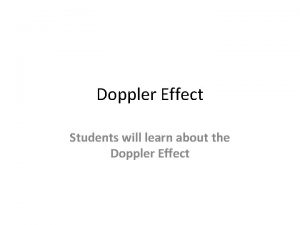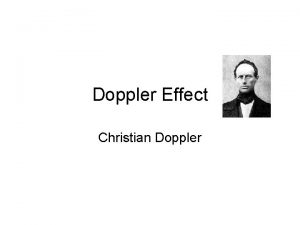Doppler reflectometer in the JT60 SA tokamak Status





















- Slides: 21

Doppler reflectometer in the JT-60 SA tokamak Status Report D. Carralero 1, T. Happel 2, T. Estrada 1, J. Martínez, J. García 3, E. de la Luna 1, T. Tokuzawa 4 1 Laboratorio Nacional de Fusión Ciemat, Av. Complutense 40, 28040 Madrid, Spain für Plasmaphysik, Boltzmannstr. 2, D-85748 Garching, Germany 3 CEA, IRFM, 13108 Saint-Paul-lez-Durance, France 4 National Institute for Fusion Science 322 -6 Oroshi, Toki-city, 509 -5292, Japan 2 Max-Planck-Institut D. Carralero et al. WPSA PM, 1 -IV-2020

Intro: why a Doppler reflec in JT-60 SA? JT-60 SA research strategy states that: “The validation of theoretical models and simulation codes with the aim of establishing a solid basis for the design of ITER and DEMO scenarios is one of the main objectives of the JT-60 SA scientific program. ” JT-60 SA Research Plan, v 3. 3 (2016) Turbulent transport of heat, momentum and particles is a major uncertainty: • JT-60 SA will provide not only an increased range of parameters (b, n*, r*, etc), but also qualitatively different situations, closer to ITER/DEMO operational scenarios. • Transport-related extrapolations used by current codes must be validated. The main messages of this proposal are: A DR is a particularly useful diagnostic for this job. Our proposal covers the diagnostic design, implementation, and scientific operation and exploitation. It is being developed by an interdisciplinary, multinational team including members from both the EU (CIEMAT, IPP, Oxford) and Japan (NIFS/SOKENDAI). D. Carralero et al. WPSA PM, 1 -IV-2020 1/7

Main Features of a Doppler diagnostic Turbulence measurements • Good for quantitative analysis: k⊥-selective, radial scans of the amplitude of local density fluctuations. By correlation studies, average size and tilt of turbulent structures can be measured. • Good coverage: by using an steerable mirror, a range of k⊥ values can be probed. Typical values are in the k⊥rs ~ 1 -10, appropriated to observe ITG and TEM turbulence. • Good temporal, spatial, spectral resolution: typical values are Dtturbulence < 1 ms, Dr ~ 1 cm, D k⊥ ~ 1 cm-1. Typical radial range covers SOL, edge and core (r > 0. 5, see later). • Good comparison to gyrokinetic models: by implementing GK model output in a full-wave code, a direct comparison between simulation and experiment is posible. Flow measurements • Besides turbulence measurements, DR provides radial scans of the u⊥ of turbulent structures. By estimating vphase using simulations or assuming vphase << v. Ex. B , Er profiles can be obtained. This allows for direct comparison between turbulence amplitude and Er shear. • Calculating neoclassical flow contributions in a tokamak, utoroidal can be obtained from u⊥. By this, a DR system can be used to carry out studies in rotation and neoclassical viscosity (regardless of NBI penetration). D. Carralero et al. WPSA PM, 1 -IV-2020 2/7

Basic system description The most likely position for the DR system would be the P 18 -Horizontal diagnostic flange. P 18 -Horizontal The bottom third of the port is used for light guides which might be removed after 2023. Details remain TBD. EDICAM Visible TV Neutron monitor Bolometer Light guide N. Oyama, PID U 2 JYv 4. 0, 2018 author | venue | date | place| D. Carralero et al. WPSA PM, 1 -IV-2020 3/7

Feasibility study in JT-60 SA A first feasibility study was conducted in order to determine the existence of a geometric solution (launching angles, position) for the DR to probe a likely JT 60 SA scenario in the region and range of k⊥ values of interest. As a working hypothesis, a launching position at one of the lower ports of the P 18 diagnostic flange has been considered, between the vacuum vessel and the stabilising plate. Final launching position still TBD. R = 4216 mm • Selected launching coordinates : position R = 4500 mm, z = -640 mm + P 18 port • Results do not depend strongly on the precise position of the antenna. R = 4954 mm • Other potential launching positions could be evaluated Launching position N. Oyama, PID U 2 JYv 4. 0, 2018 D. Carralero et al. WPSA PM, 1 -IV-2020 4/7

Feasibility study: Ray tracing A first feasibility study was conducted in order to determine the existence of a geometric solution (launching angles, position) for the DR to probe a likely JT 60 SA scenario in the proposed region and range of k⊥ values. Ray tracing code TRAVIS has been used to determine optimal launching angles for the proposed frequency bands. The criteria were: • Minimize k|| to at most, k||/k⊥ < 0. 1 (required for acceptable S/N ratio) • Reflection layers close to the OMP (ballooning character of turbulence suggest optimum S/N levels) • Single-axis rotation in steering mirror (minimize complexity of mechanical system) • k⊥rs in the 1 -10 range (ITG/TEM turbulence) D. Carralero et al. WPSA PM, 1 -IV-2020 4/7

Regions of interest Standard H-mode scenario Taking into account recent scenario predictions, three distinct regions of interest are foreseen: - Observation of core turbulence • r < 0. 8, ne ~ 4 -7. 5 1019 m-3 • Examples: TEM turbulence, ITB formation. - Observation of pedestal region: Advanced steady state, high power scenario • • r > 0. 8, ne ~ 2 -5 1019 m-3 Example: L-H transition, ETB formation. - Observation of SOL region: • • r > 1, ne < 2 1019 m-3 Example: SOL Er, filamentary activity. This presentation covers the first two regions. The SOL observations are being developed by T. Tokuzawa (R. O. ). L. Garzotti et al. , NF 2018 D. Carralero et al. WPSA PM, 1 -IV-2020 5/7

Results: High density scenario Freqs at equatorial plane q= q= q= 34 9º 39 º . 1º q = 29 q = 24 W-band 43. . 1º . 3º E-band • Central region can be completely covered by W-band in O-mode. • Edge (up to LCFS) can be covered by E-band in X-mode. • This way, k⊥, core = 5 -30 cm-1 and k⊥, edge= 3 -20 cm-1 can be obtained with k||/k⊥< 0. 1 D. Carralero et al. WPSA PM, 1 -IV-2020 6/7

Results: Hybrid scenario Freqs at equatorial plane q= W-band. 9º 43 q = 39 º q= 34 . 1º 2 xfec absorption q=2 9. 1º q=2 4. 3º E-band • Central region can be completely covered by E-band in O-mode. • Edge (up to LCFS) can be covered by E-band in X-mode. • This way, k⊥, core = 5 -25 cm-1 and k⊥, edge= 5 -25 cm-1 can be obtained with k||/k⊥< 0. 1. • W-band is strongly absorbed by the 2 nd EC harmonic in X-mode. D. Carralero et al. WPSA PM, 1 -IV-2020 6/7

Current status of conceptual design Elliptic mirrors RF windows Ø 200 mm RX TX Port plug Directional coupler (E-band) Optimized antenna A viable conceptual design has been found for a V/W band DR: • Monostatic system. 30 mm beam waist @ cut off position for 90 GHz (1. 4 m distance). • The whole system is contained in a 200 mm diameter port plug. • Q-band might be fitted in the second circular port (T. Tokuzawa) Space limitations impose a number of critical restrictions: • Only one band at a time can be used (only core/edge observation). • The system only admits one polarization mode (O/X). • There is not enough space for antenna steering (no spectrum measurements). D. Carralero et al. WPSA PM, 1 -IV-2020 7/7

Current status of conceptual design Elliptic mirrors RF windows Ø 200 mm RX TX Port plug Directional coupler (E-band) Optimized antenna A viable conceptual design has been found for a V/W band DR: • Monostatic system. 30 mm beam waist @ cut off position for 90 GHz (1. 4 m distance). • The whole system is contained in a 200 mm diameter port plug. • Q-band might be fitted in the second circular port (T. Tokuzawa). A better scenario involves access to the whole 700 -400 mm space: • All features could be implemented (SOL/core/edge, steerable mirror, …). • Probably, the whole space wouldn´t be needed. Flexible solutions, involving aditional diagnostics, continuation of light guides would be possible. D. Carralero et al. WPSA PM, 1 -IV-2020 7/7

Current status of conceptual design Elliptic mirrors RF windows Ø 200 mm RX TX Port plug Directional coupler (E-band) Optimized antenna A viable conceptual design has been found for a V/W band DR: • Monostatic system. 30 mm beam waist @ cut off position for 90 GHz (1. 4 m distance). • The whole system is contained in a 200 mm diameter port plug. A Doppler reflectometer in JT 60 -SA is possible: Our analysis has identified • K-bandseveral might be fitted insolutions the second circular port address (T. Tokuzawa). working which could the physics program. A better scenario involves access theneed whole 700 -400 mminformation space: In order to go into further detail, towe more detailed regarding • All features could be implemented (SOL/core/edge, available space. steerable mirror, …). • Probably, the whole space wouldn´t be needed. Flexible solutions, involving aditional diagnostics, continuation of light guides would be possible. D. Carralero et al. WPSA PM, 1 -IV-2020 7/7

Additional Slides D. Carralero et al. WPSA PM, 1 -IV-2020

Feasibility study in JT-60 SA A first feasibility study has been conducted in order to determine the existence of a geometric solution (launching angles, position) for the DR to probe a likely JT -60 SA scenario in the proposed region and range of k⊥ values. As a working hypothesis, a launching position at one of the lower ports of the P 18 diagnostic flange has been considered. Final launching position still TBD. Two scenarios from the scientific plan have been considered: High density Hybrid D. Carralero et al. WPSA PM, 1 -IV-2020 8 / 14

Feasibility study: Ray tracing A first feasibility study has been conducted in order to determine the existence of a geometric solution (launching angles, position) for the DR to probe a likely JT-60 SA scenario in the proposed region and range of k⊥ values. Ray tracing code TRAVIS has been used to determine optimal launching angles for the proposed frequency bands. top view poloidal view + + D. Carralero et al. WPSA PM, 1 -IV-2020 9 / 14

Turbulence-GK simulation comparison In AUG, the turbulence field has been calculated using flux-tube, non-linear GENE simulations. Using said field as an input for 2 DFW code, a synthetic DR output is obtained. This allows for a direct comparison of DR output and GK turbulence predictions. T. Happel et al. , 13 th Int. Reflect. Workshop, 2017 & T. Happel et al. , PPCF 2017 D. Carralero et al. WPSA PM, 1 -IV-2020 3 / 14

Rotation and NTV Suficient rotation is required for high-b MHD stability. • Predictive simulations show that NTV torque may be equivalent to that of NBI drive when axisymmetry is lost. • Strong impact in rotation, which will be substantially reduced. • Simulation-experiment comparisons are required to validate models. JT-60 SA (AI scenario), TOPICS simulation DIII-D M. Honda et al, NF, 2014 Er may also be relevant for impurity transport • For large enough deviation of axisymmetry, impurity transport might become driven by Er, as typically in stellarators. A. J. Cole et al, NF, 2011 D. Carralero et al. WPSA PM, 1 -IV-2020 5 / 14

Main Features of a Doppler diagnostic Turbulence measurements • Good for quantitative analysis: k⊥-selective, radial scans of the amplitude of local density fluctuations. By correlation studies, average size and tilt of turbulent structures can be measured. • Good coverage: by using an steerable mirror, a range of k⊥ values can be probed. Typical values are in the k⊥rs ~ 1 -10, appropriated to observe ITG and TEM turbulence. • Good temporal, spatial, spectral resolution: typical values are Dtturbulence < 1 ms, Dr ~ 1 cm, D k⊥ ~ 1 cm-1. Typical radial range covers SOL, edge and core (r > 0. 5, see later). • Good comparison to gyrokinetic models: by implementing GK model output in a full-wave code, a direct comparison between simulation and experiment is posible. D. Carralero et al. WPSA PM, 1 -IV-2020 2 / 14

k-spectra characterization A number of rays are launched on the optimal plane to simulate different launching angles from a steerable mirror. O-mode, 60 GHz elevation angle azimuth angle k||/k⊥ = 0. 1 k|| = 0 D. Carralero et al. WPSA PM, 1 -IV-2020 11 / 14

Results: High density scenario Freqs at equatorial plane q= q= q= 34 9º 39 º . 1º q = 29 q = 24 W-band 43. . 1º . 3º E-band • Central region can be completely covered by W-band in O-mode. • Edge (up to LCFS) can be covered by E-band in X-mode. • This way, k⊥, core = 5 -30 cm-1 and k⊥, edge= 3 -20 cm-1 can be obtained with k||/k⊥< 0. 1 D. Carralero et al. WPSA PM, 1 -IV-2020 6/7

Results: Hybrid scenario Freqs at equatorial plane q= W-band. 9º 43 q = 39 º q= 34 . 1º 2 xfec absorption q=2 9. 1º q=2 4. 3º E-band • Central region can be completely covered by E-band in O-mode. • Edge (up to LCFS) can be covered by E-band in X-mode. • This way, k⊥, core = 5 -25 cm-1 and k⊥, edge= 5 -25 cm-1 can be obtained with k||/k⊥< 0. 1. • W-band is strongly absorbed by the 2 nd EC harmonic in X-mode. D. Carralero et al. WPSA PM, 1 -IV-2020 6/7
 Tokamak
Tokamak Tokamak működése
Tokamak működése Equation of motion
Equation of motion Golem tokamak
Golem tokamak Tokamak
Tokamak Hl2 tokamak
Hl2 tokamak Harry potter arnold
Harry potter arnold Tokamak hl-2m
Tokamak hl-2m Fuzn
Fuzn Neurology sonography
Neurology sonography Tissue doppler imaging
Tissue doppler imaging Effet doppler
Effet doppler Efecto doppler longitud de onda
Efecto doppler longitud de onda Weather blacksburg va 24061
Weather blacksburg va 24061 Doppler effect meteorology
Doppler effect meteorology Doppler de poche mesure ips
Doppler de poche mesure ips Magneto optical trap
Magneto optical trap Duplex doppler ultrasound
Duplex doppler ultrasound Doppler tsa
Doppler tsa Renal index
Renal index Doppler effect formula
Doppler effect formula Sorgente ferma e ricevitore in movimento
Sorgente ferma e ricevitore in movimento
